Web3 DApp Best Programming Practice Guide

This article will cover almost all aspects of DApps development. Therefore, it will be very tedious and cumbersome. If you are particularly interested in a certain aspect, I suggest that you can jump directly to the one you are interested in through the directory below. Chapter reading. In addition, this article is not a code teaching example of Step by Step, so skipping chapter reading will not affect the experience.
Get to know the DApp technology stack
The biggest difference from traditional App (including Web App and Mobile App) is that a large number of functions of DApp rely on direct interaction with smart contracts (hereinafter referred to as contracts). We cannot use front-end code to call contracts directly, DApps Development Services so before developing a DApp, we must understand what technical details exist in this technology stack and what role they each play.
Smart Contract : Usually refers to Solidity or other contract language code running in an EVM-compatible network , they are responsible for trading our issued assets with users and storing the on-chain state of the DApp.
DApp : An application program interface that integrates contract interfaces and other functions. Currently, most of them are Web Apps, which you can write with popular frameworks such as React / Vue .
Provider/Signer : This is a special role in the DApp architecture, which is responsible for communicating with the blockchain and performing contract read/write operations. Metamask is a popular InjectProvider (Web3Provider) You can also use other JSON-RPC Providers to communicate with the blockchain.
Relay : This role is hidden behind the Provider/Signer. It is the server cluster that is really responsible for our synchronization with a node of the blockchain. It saves all ledgers (full nodes). It is usually Infura , Alchemy , Quicknode , Moralis or Pocket service provided.
Server-side (optional): Most DApps still have their server-side logic, which means, you need to build the service environment yourself, or use popular BasS/FaaS services, you can use Moralis, which is deeply integrated with the blockchain. For server-side development, you can also use the mature Firebase system. Of course, you can also challenge building DApps in a completely server-free way, as Uniswap has done.
Now, we know what fields of knowledge are required to write a DApp. If you have decided to move towards the next generation of the Internet and plan to make a fortune, I will explain in detail in the following content which programming languages, frameworks and library.
Let’s get to the most important part first, smart contracts . An important threshold for a large number of programmers to be discouraged is that they believe that smart contracts need to learn a new programming language, Solidity , which is without a doubt, I highly recommend programmers starting Web3 — no matter which software development field you are transitioning from. Come — learn DApps development company from Solidity.
In the coding of smart contracts, we currently have many tools, but it is very necessary to know and understand Solidity. A large number of existing and popular contracts are coded using it. Therefore, learning Solidity will not only help you understand the area The basics and concepts of blockchain development can also get you started quickly on the excellent engineering that many excellent developers already have.
As far as programming languages are concerned, on the current EVM-compatible chain, you can use Solidity or Vyper for development, and on other L1s blockchains, such as Solana , you can use Rust for contract development; in the Layer2 scheme StarkNet , You can use Cairo for development; in the Arweave storage network, there are also runtime environments like 3em that allow you to write contracts in JavaScript.
In these schemes, there are actually two different contract running environments, EVM or non-EVM scheme, the code of the former will be compiled into EVM bytecode, while the latter will use various runtimes, each showing its magical powers .
This article will not discuss too much on contract programming languages. I think that we are currently in the Warring States era of contract runtime, and no one can assert which contract programming language will become the JavaScript of the web world. But for smart contract coding, we must understand and be familiar with Solidity DApps Development Solutions , there is no doubt.
This tutorial does not have a tedious introduction to syntax, and uses examples to help readers master the basics, so it takes less than one working day to complete this tutorial . Solidity is not a particularly complex language. When using it, we can gradually understand the semantics of each statement. I recommend that you set up the coding environment and practice according to the examples on the website. After you have mastered the writing methods of all the examples, you can open the official Solidity language documentation ( Chinese ) to compare the errors in the coding for targeted learning
Smart contract coding
In this chapter, we will start with the Solidity language to understand how writing a smart contract is different from traditional application software or interfaces. You can use other Build a cross chain bridge programming languages mentioned in the previous chapter, but this chapter will use Solidity (hereinafter referred to as Sol) is used as an example to illustrate the issues that should be paid attention to in smart contract coding.
Here, I will not explain the semantic details of the Sol language line by line, so reading this chapter requires you to have a minimum knowledge of the Sol language.